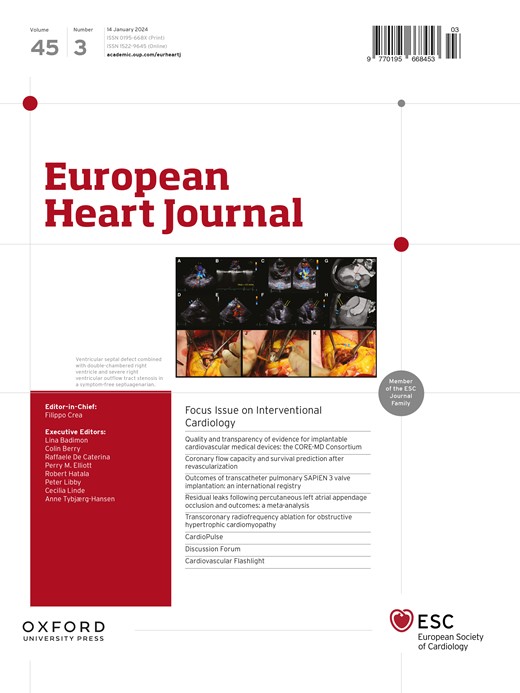Transthyretin amyloid cardiomyopathy: from cause to novel treatments.
IF 35.6
1区 医学
Q1 CARDIAC & CARDIOVASCULAR SYSTEMS
引用次数: 0
Abstract
Transthyretin amyloid cardiomyopathy (ATTR-CM) is a progressive disorder marked by amyloid deposition in the heart, ultimately impairing cardiac function. Recent treatment advances have paralleled an evolving understanding of ATTR-CM pathophysiology. One emerging hypothesis suggests that an imbalance between in vivo amyloid production and natural clearance may drive disease progression, a conceptual framework that still requires validation. Transthyretin (TTR) stabilizers, such as tafamidis and acoramidis, mitigate amyloid formation by promoting the native tetrameric conformation of circulating TTR, thereby slowing functional decline and prolonging survival. Similarly, TTR gene silencers inhibit hepatic TTR synthesis, and gene-editing therapy with nexiguran ziclumeran offers an additional strategy to reduce amyloid production. However, these approaches do not enhance the body's limited capacity to clear existing amyloid deposits, underscoring the need for novel agents that accelerate amyloid removal. Promisingly, monoclonal antibodies targeting TTR amyloid are under development, with early clinical trials suggesting that this passive immunotherapy may reverse disease progression and improve heart function. Ultimately, optimal management of ATTR-CM will require further elucidation of the complex interplay between amyloid formation, its structural and functional impacts, its clearance mechanisms, and the potential for myocardial reverse remodelling.转甲状腺素淀粉样心肌病:从病因到新疗法。
转甲状腺素淀粉样心肌病(atr - cm)是一种以淀粉样蛋白沉积在心脏为特征的进行性疾病,最终损害心功能。最近的治疗进展与对atr - cm病理生理的不断发展的理解是平行的。一种新出现的假说认为,体内淀粉样蛋白产生和自然清除之间的不平衡可能驱动疾病进展,这一概念框架仍需要验证。转甲状腺素(TTR)稳定剂,如tafamidis和acoramidis,通过促进循环TTR的天然四聚体构象来减轻淀粉样蛋白的形成,从而减缓功能衰退并延长生存期。同样,TTR基因沉默剂抑制肝脏TTR合成,耐西古兰ziclumeran基因编辑治疗提供了一种减少淀粉样蛋白产生的额外策略。然而,这些方法并不能提高人体清除现有淀粉样蛋白沉积物的有限能力,因此需要新的药物来加速淀粉样蛋白的清除。有希望的是,针对TTR淀粉样蛋白的单克隆抗体正在开发中,早期临床试验表明这种被动免疫疗法可能逆转疾病进展并改善心脏功能。最终,atr - cm的最佳管理将需要进一步阐明淀粉样蛋白形成、其结构和功能影响、其清除机制以及心肌逆向重构的潜力之间的复杂相互作用。
本文章由计算机程序翻译,如有差异,请以英文原文为准。
求助全文
约1分钟内获得全文
求助全文
来源期刊

European Heart Journal
医学-心血管系统
CiteScore
39.30
自引率
6.90%
发文量
3942
审稿时长
1 months
期刊介绍:
The European Heart Journal is a renowned international journal that focuses on cardiovascular medicine. It is published weekly and is the official journal of the European Society of Cardiology. This peer-reviewed journal is committed to publishing high-quality clinical and scientific material pertaining to all aspects of cardiovascular medicine. It covers a diverse range of topics including research findings, technical evaluations, and reviews. Moreover, the journal serves as a platform for the exchange of information and discussions on various aspects of cardiovascular medicine, including educational matters.
In addition to original papers on cardiovascular medicine and surgery, the European Heart Journal also presents reviews, clinical perspectives, ESC Guidelines, and editorial articles that highlight recent advancements in cardiology. Additionally, the journal actively encourages readers to share their thoughts and opinions through correspondence.
 求助内容:
求助内容: 应助结果提醒方式:
应助结果提醒方式:


